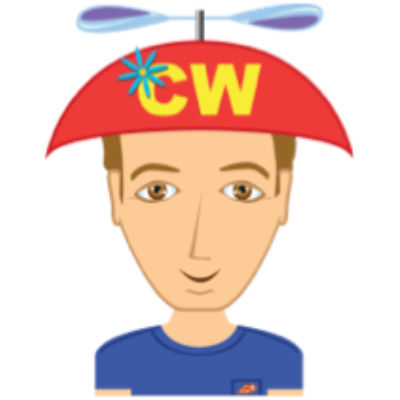Pandemics & People
Designing a Virtual Epidemic Event for Immersive, Connected, and Playful Participation in an Infectious Disease Outbreak
Abstract
Researchers and educators have identified an urgent need for more rigorous teaching and learning about epidemiology topics and practices, such as engaging in behaviors that prevent the spread of viral disease such as COVID-19. Responding to this need, we designed a virtual epidemic as a special event hosted in a virtual world. In this paper we share the strategic, tactical, and detailed design of the SPIKEY-20 virtual epidemic and data that reflects back on the design in terms of player participation. Reflecting on the design, we ask: What kinds of players participated in the SPIKEY-20 virtual epidemic? How did players engage in designed activities (i.e., preventive measures, information seeking)? In what ways were players influenced by the concurrent real world pandemic of COVID-19? In the discussion we consider the potential connection points between real-life and virtual public health behaviors, new possibilities of classroom participation and teacher support for such a virtual event, and future design considerations for virtual epidemics.
Introduction
“Virtual worlds are the place where the imaginary meets the real.”
Virtual worlds, whether designed as a multiplayer game (i.e., World of Warcraft) or more as a social space (i.e., Second Life), hold creative design and research potential for their massive size and player population, their unique forms of communication and interaction, and the space for players to create and interact with artifacts like homes, avatars, and communities (Oultram, 2013; Kafai & Fields, 2013). In particular, thanks to their large populations, virtual worlds provide a unique opportunity to engage and study players in experiential learning of issues that pose societal-level challenges, such as economic, environmental, or public health issues (Barab et al., 2012; Castranova, 2005; Dede et al., 2004). These types of problems are not caused by and cannot be resolved by a single person’s or small group’s actions but rather require a collective response from a community. Virtual worlds provide a means to mirror societal issues at the scale of a massive community, allowing direct, immersive participation with relatively little harm, for instance with environmental or public health issues such as epidemics. In this paper we consider the timely design of a virtual epidemic as a community event in a virtual world to study players’ engagement in an infectious disease outbreak.
As countries and communities race to engage all citizens in participatory public health behaviors to contain the spread of infection with COVID-19, researchers and educators have identified the need for more rigorous teaching and learning about epidemiology topics (including concepts such as vectors of disease spread and population statistics) and practices (including using personal protective equipment (PPE) and engaging in preventive behaviors). Until recently, teaching and learning about infectious disease has not been a high educational priority (e.g., the Next Generation Science Standards do not explicitly address this topic for any age range in US K-12 schooling; NGSS, 2013), prompting Timmis and colleagues (2019) to voice an urgent call for “microbial literacy”. Critically, citizens must explore not only individual-level biological concepts and processes (e.g., germs, infection, incubation, and immunity), but also communal and population level contexts and factors that may contain (or exacerbate) a disease outbreak. One component of COVID-19 that brought epidemiological topics to public awareness was the rapid rate of spread among asymptomatic individuals, highlighting the key role that preventive behaviors, testing, and understanding of incubation periods can play in controlling outbreaks. The impact of individual actions and behavioral changes on society-level infection and immunity is a critical connection point between real-world epidemics and designed, virtual world epidemics. By providing opportunities for immersive and playful enactment of public health practices, we suggest that virtual epidemics—as special events hosted in virtual worlds—can reinforce participatory behaviors and communal knowledge that may prevent real-world public health crises. On the border of the imaginary and the real, virtual epidemics offer people an authentic context to experience and examine critical features of infectious disease without being physically affected.
Core to a virtual epidemic are the rules of design: how it spreads, what symptoms it causes in an avatar (i.e., the virtual character players inhabit), how infectious it is, and so forth. It is a computational entity with designed probabilistic characteristics, affected by players’ actions. As such, virtual epidemics share many parallels with real epidemics, as epidemiologists have noted (Lofgren & Fefferman, 2007; Oultram, 2013), and could also help people understand and predict spread in a population dependent on players’ online collective behaviors. At the same time, as an event, virtual epidemics must motivate player participation, perhaps in reaction to avatar symptoms or social pressures. In Fall 2020, building on earlier foundational research and designs (Fields et al, 2017; Kafai & Fields, 2013), we launched just such a virtual epidemic in the virtual world of Whyville.net: SPIKEY-20.
Our goal was to provide opportunities and instigation for people to learn about epidemic outbreaks through immersion, connection, and play during the SPIKEY-20 epidemic. Immersion refers to the experiential, participatory nature of the virtual world, where players are active contributors to the viral simulation. Individual actions (or decisions not to act, i.e., not wearing PPE) impact community-level infection patterns in the virtual epidemic. Connection refers to the discernible ways that the virtual epidemic was designed to mirror real-life epidemics (specifically COVID-19), in order to support conceptual connections about preventive behaviors and concepts that might transfer beyond the virtual world. Finally, play refers to the playful, fantasy aspects of the epidemic, engaging users in light-hearted inquiry and the ability to experiment without trauma or anxiety induced by real-world connections and immersion. Choosing a virtual world as our platform (rather than a boardgame or an individual classroom setting), allowed us to use these three principles to contextualize learning for players in a social, non-academic space.
In this paper we share the tactical, strategic, and detailed design principles (Burkhardt & Pead, 2020) behind the design of the SPIKEY-20 virtual epidemic, the various components of the design itself, and data that reflects back on the design in terms of player participation. We were particularly cognizant of a similarly designed virtual epidemic in Whyville from Fall 2015, the Dragon Swooping Cough, that intentionally mirrored Ebola, an epidemic that, in contrast to COVID-19, rarely impacted people’s everyday lives outside of Africa. In contrast, SPIKEY-20 in Fall 2020 took place when the COVID-19 pandemic was widely spread throughout the world. With the past virtual epidemic and the present real pandemic in mind, in this paper we share the design of the SPIKEY-20 virtual epidemic and further ask:
-
What kinds of players participated in the SPIKEY-20 virtual epidemic?
-
How did players engage in designed, epidemic-related activities (i.e., preventive measures, information seeking)?
-
In what ways were players influenced by the concurrent real world pandemic of COVID-19?
To answer these questions, we draw on surveys from hundreds of participants and logfiles from thousands of participants to understand how people interacted with the SPIKEY-20 virtual epidemic, and how their engagement was influenced by their experiences with the active COVID-19 pandemic. In the discussion we consider what this means for the design of future virtual epidemics.
Background
Virtual Epidemics in Virtual Worlds
In his now seminal book, Bartle (2003) defines virtual worlds as digital spaces where players can effect changes (though not to the underlying digital rules that define them), where players are “individuals” with one game avatar through which all interaction is channeled, and where interaction takes place in real time in a shared world that is persistent. Virtual worlds are primarily social spaces where players inhabit a character that they create that may or may not have some semblance of their “real” persona and where players can converse through chat in some form. It is in this designed space where “the imaginary meets the real” (p. 2) that virtual worlds can become a place to design interactive experiences for complex, real life problems such as virtual epidemics.
Indeed, virtual epidemics may provide a particularly apt opportunity to help people experience and learn about the role of probability in infectious disease spread at population levels, as well as its dependence on societal behaviors, a concept challenging for children and youth to understand (e.g., Sigelman & Glaser, 2019; Wilensky & Abramson, 2006). Further, being computational in nature, virtual epidemics allow designers the opportunity to make transparent the role of player behavior in viral spread with the data gathered in the digital space. Ideally this could allow players to investigate the relationships between infection parameters and social dynamics, the very same questions that interest real-world epidemiologists (Schott & Hodgetts, 2006).
A unique challenge in designing virtual epidemics is that they are real-time events that change based on the collective actions of players. Designing an event is unlike creating an instructional tool for design, such as games (e.g., Reeves, 2011), programmed artifacts (e.g., Resnick & Silverman, 2005), or task-based activities (e.g., Ba & Abrahamson, 2021). As real-time events that can draw in a broad range of participants from many locales at the same time, they are also different from bounded and supported educational activities such as summer workshops or informal out-of-school programs (e.g., Puttick, Bernstein & Edwards, 2018). Virtual epidemics are time-constrained, their length dependent on the activity and presence of players to spread or contain the epidemic. Players also have the potential for community activism, mischief, and research. Further, no individual player is able to control the situation. This is different from games that simulate epidemics like Plague (Ndemic Creations, 2012) and Pandemic (Asmodee Digital, 2014) where one or a few players control the entire game. One unplanned virtual epidemic, the Corrupted Blood outbreak in the World of Warcraft, demonstrated the potential for player engagement (Lofgren & Fefferman, 2007). Players experienced real life-like emotions of grief as their avatars actually perished with infection. Yet players also took surprising risks to explore and understand the disease. This unplanned virtual epidemic demonstrated the potential for thoughtful player engagement in designed virtual epidemics.
Designing Virtual Epidemics
Our work on the SPIKEY-20 virtual epidemic drew on experience with two other designed epidemics in Whyville. Our first designed virtual epidemic, WhyPox, provided only some options for players to change the course of the epidemic: avatars showed symptoms (red spots on avatars and sneezes during conversations) but could do little to prevent the spread of the virus outside of not going online. Still, they could play with simulators to understand disease spread and study a graph of the infection curve (e.g., number of infections per day) to try to understand the epidemic. In later years of WhyPox, designers began to add some abilities for preventing spread: washing hands and covering mouths (triggered by typing “wash” or “cover” into chat). They also provided some measures to reduce symptoms, which greatly pleased players annoyed by the spots or sneezes. In general, Whyvillians drew parallels between WhyPox and other diseases (e.g., flu) in chat, wrote community posts on disease spread, played simulators in thoughtful ways, donated to the community fund to create a vaccine, and engaged in vaccination efforts (Neulight et al., 2007; Kafai & Giang, 2007; Kafai et al., 2007; Kafai et al., 2010; Kafai & Fields, 2013).
Our second virtual epidemic, Dragon Swooping Cough (DSC, 2015-2016), was developed to provide players with more means of active engagement. It emulated a skin-based epidemic spread in response to the Ebola epidemic, even though Ebola was largely contained outside of North American and European borders (Fields et al., 2017). Like WhyPox, avatars showed symptoms like scales and coughs, plus new symptoms of movement. To convey the skin-based mode of infection, avatars shed scales during a looping swoop around the screen. In addition, we included economic consequences to the epidemic—avatars received no salary for the three worst days of infection—and new preventive measures further mirrored the economics of epidemics: cheap but less effective single-use masks and sanitizer, and highly expensive and very effective biohazard umbrellas. Research demonstrated that many players were emotionally engaged during DSC (Ibid.). Most players disliked the virus, finding the symptoms annoying, and only a small percentage liked it, primarily those who found it game-like or cute, with a few who thought it educational. All emotional engagement (whether liking it or disliking it) was correlated with taking more epidemic actions, including information seeking and preventive behaviors (Ibid.). In addition, we noted a distinct change in preventive behaviors in the early weeks of the virus as players started by using preventive behaviors successful for WhyPox (presumably based on prior experience) but shifted to more successful DSC-specific preventive behaviors (e.g., masks, sanitizer).
With this background, we designed the SPIKEY-20 epidemic in direct response to COVID-19. The context for SPIKEY-20 was different from earlier designs in two significant ways. First, the population of Whyville has changed since its inception in 1999. While teen players still join and participate, as of this writing the population now includes a number of adults, many who were teens in the early 2000s that continue to participate and keep up with friends on Whyville. Further, in 2017, Whyville made classroom accounts available, where teachers could create accounts for students and control whether the students could see players’ chat outside of the class as a safety measure. Notably for this study, classroom accounts grew substantially during school lockdowns of Spring 2020 in response to the pandemic, and we were able to discern in logfile data whether participants were members of registered classrooms. Second, unique for previously designed virtual epidemics, SPIKEY-20 took place during an actual pandemic affecting nearly every person’s everyday life. With these two changes in virtual and real life contexts, we sought to understand how players responded to the SPIKEY-20 epidemic in Fall 2020. Below we describe the principles that drove our design before sharing how players responded.
Design Strategies for Virtual Epidemics
Following the model of Burkhardt and Pead (2020), we introduce our epidemic design through different layers: strategic, tactical, and detailed designs. At a high level is the strategic design, namely, to immerse players in an epidemic that was close enough to real life respiratory epidemic features. Here players could make real life connections, playful enough to allow for activities that in real life would be unsafe or too traumatically close to the COVID-19 epidemic (see also Kafai & Fefferman, 2010). Below we consider each of these goals in turn.
Immersion
With SPIKEY-20, we sought to create an immersive simulation of an epidemic that would actively engage players. To this end we followed Salen and Zimmerman’s (2004) core features of meaningful play. First, that the game action must be discernible: such that the result of game action is communicated to the player (e.g., an asteroid exploding when a player hits it). Second, that the game action is integrated, in that players’ actions have both immediate and later significance in a game (e.g., the way a chess player’s early actions affect the middle and end game actions).
One particular challenge to our strategic design was making an asymptomatic infectious period—a difficult-to-grasp characteristic of many viruses—discernable to players. To accomplish this we provided unlimited, free virus testing whereby players could discern infection while asymptomatic as well as through later symptoms (visual, chat-based, economic). In addition, informational graphs and statistics provided real-time feedback to players about their actions on a world-scale (i.e., one could see the infection curve grow or shrink). We designed integrated play through preventive measures whereby players’ use of PPE and handwashing or covering lowered the likelihood of infection in the virus algorithm. These provided immediate significance as players saw each other wearing PPE and later significance by affecting the epidemic’s progression.
Connections
Taking advantage of the amorphous line between the imaginary and the real in virtual worlds (Kafai & Fields, 2013), we designed four means for players to make connections between real and virtual epidemics:
-
observable viral periods (i.e., infectious, symptomatic and asymptomatic, incubation periods),
-
economics (i.e., loss of income, differential expenses for PPE),
-
player practices (i.e., wearing preventive equipment, washing hands, getting tested), and
-
representations of infections players (i.e., infection graphs, news announcements, some symptoms).
While the parallels between the virtual SPIKEY-20 epidemic and the COVID-19 pandemic are not exact, we hoped players would make connections through these aspects.
Playful
Finally, the virtual epidemic also needed to be playful. We did not want to add to players’ trauma or stress from the epidemic in real life but sought to give them a safe and fun place to learn and experiment. We considered a three-part perspective of play in our design, elaborated by Kafai and Fields (2013). First, play has a developmental role (e.g., Vygotsky, 1978), and can provide opportunities and challenges for people to learn to navigate new situations and try on roles and practices (e.g., being infected, investigating an epidemic, stopping infectious spread). Second, play is cultural (e.g., Goodwin, 1985), so it comes with values and rules and can be a space where players can explore, test, and experiment with those values (e.g., spreading an epidemic instead of preventing it; wearing or not wearing a mask). Third, play in virtual worlds is interpreted through media (e.g., Jenkins et al., 2009) such as portrayals of information (e.g., infection graphs), preventive medical gear for avatars, and discernable symptoms. Below we share about the more tactical or pragmatic design of the virtual epidemic that we sought to be immersive, connected, and playful.
Design Features of the SPIKEY-20 Virtual Epidemic
Tactical Design Features
Our tactical design primarily includes the structural features of the virtual epidemic: the design of the virus as well as the range of preventive behaviors and equipment players could use to limit infectious spread.
We identified three overlapping, tactical design goals for the SPIKEY-20 virus, which we outline here along with our overarching goals for the detailed design described in more detail below. First, we infected a lot of people quickly to create an immersive shared play experience in the Whyville community, which involved a relatively high “R number” of the virus and viral periods with an overlap between latent (asymptomatic) and infectious periods. Second, we wanted to provide a discernible infection experience to players, ideally both generating an emotional response and helping players make connections to qualities of the COVID-19 pandemic. We did so by:
- designing symptoms that demonstrated infection by affecting avatars visibly, socially, and economically but were also fun and cute,
- providing testing (with false positives & negatives), to reveal an asymptomatic period, and
- offering appropriate graphs showing infections in Whyville.
Finally, we also created a range of preventive equipment and actions that provided connections to the COVID-19 virus while staying imaginary and playful. We included multiple types of visible PPE and practices with different levels of effectiveness (also related to cost). We explain the detailed enactment of these tactical designs below.
Infect Many Whyvillians
R-number & Mode of Infection
A core epidemiological attribute of viruses is the “R” number, typically defined as the number of cases, on average, an infected person will cause during their infectious period. We created a virtual, population-level approximation of R using the rate of infection in the community to initiate new infections. The mode of infection was an algorithmic probability: every player who logged in on a particular day had a probable chance of being infected based on the prior day’s number of infected individuals and the collective practice of preventive measures by players (i.e., providing integrated consequences). This way, players’ actions would make a difference on the rate of infection from day to day. The SPIKEY-20 infection launched on October 15, 2020, randomly infecting a set number of individuals who logged in, then took its course.
Viral Periods
A lengthy overlap between latent (asymptomatic) and infectious periods both mirrored the COVID-19 virus and was likely to promote quick spread. SPIKEY-20 infection lasted eight days, with overlapping viral periods laid out in Figure 1. Additionally, we hoped this model would make the epidemic accessible to classroom-based participants: long enough for students in a class to become infected and see symptoms within two weeks of school.


Enlarge…

Enlarge…
Discernable Infection Experience
Symptoms
We designed five symptoms to provide a discernable yet playful infection experience:
-
Pink spikes protruding from avatars (inspired by the iconic spiked protein image of COVID-19) that grew stronger during the infection (see Figure 2)
-
A plume emerging from players’ mouths during the three worst days of infection (to demonstrate the aerosol nature of respiratory spread) (see Figure 3)
-
Visible shaking during the three worst days of infection
-
Social interruptions to chat with the phrase: *cough* .. *cough* .. *cough*
-
Economic interruptions to players’ “clam” currency earnings: no salary deposits on the worst three days of symptoms


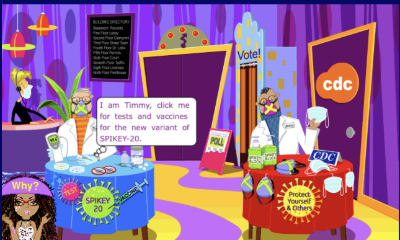
Enlarge…
Testing
Virus testing, available at the Timmy table in the Whyville City Hall Lobby (see Figure 4), was unlimited, free, and had instantaneous results (unlike in real life!), allowing for discernable knowledge of infection status even if asymptomatic.

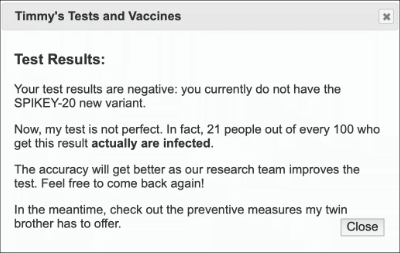
Enlarge…
In line with medical testing limitations in the real world, we incorporated probabilistic limitations, which we made visible to players: 21% false negatives and 30% false positives, reported as a ratio rather than an abstract percentage (e.g., “21 people out of 100 who get this result actually are infected”) (see Figure 5).

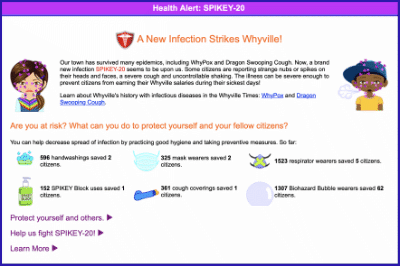
Enlarge…
Information & Graphs
We provided several different sources of discernable information within Whyville for players to learn more about the spread of SPIKEY-20.
- A homepage banner on the login screen during the epidemic, which unfurled with more information about the virus and prevention measures (see Figure 6).
- At the virtual CDC, players could view the live-tracking SPIKEY-20 Community infection graph (Figure 7a) or explore games and simulations about population variables affecting spread in disease outbreaks (Figure 7b).
- Player-generated commentary about potential disease vectors and experiences in the in-world newspaper, the Whyville Times.

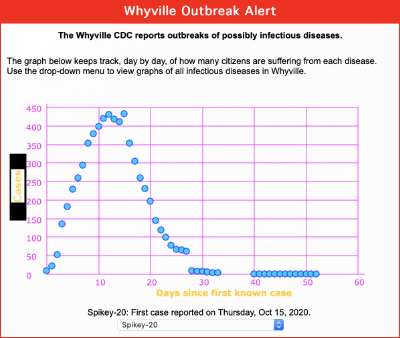
Enlarge…
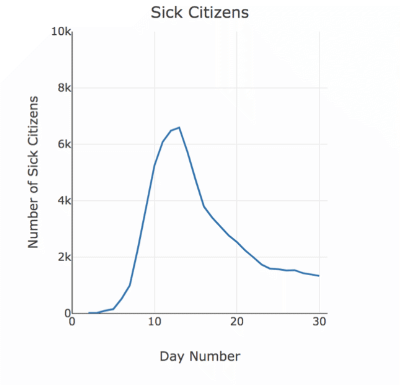
Enlarge…
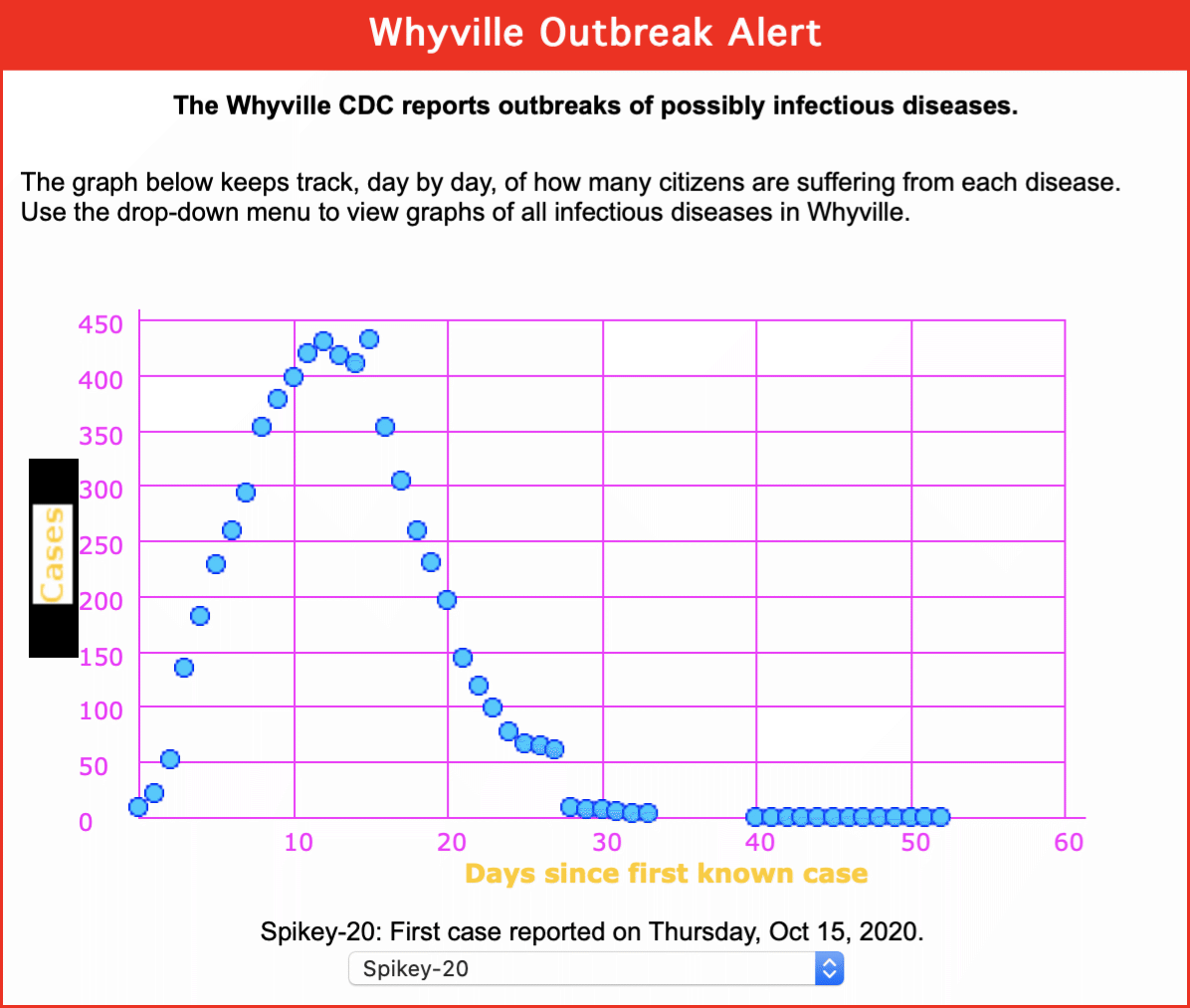
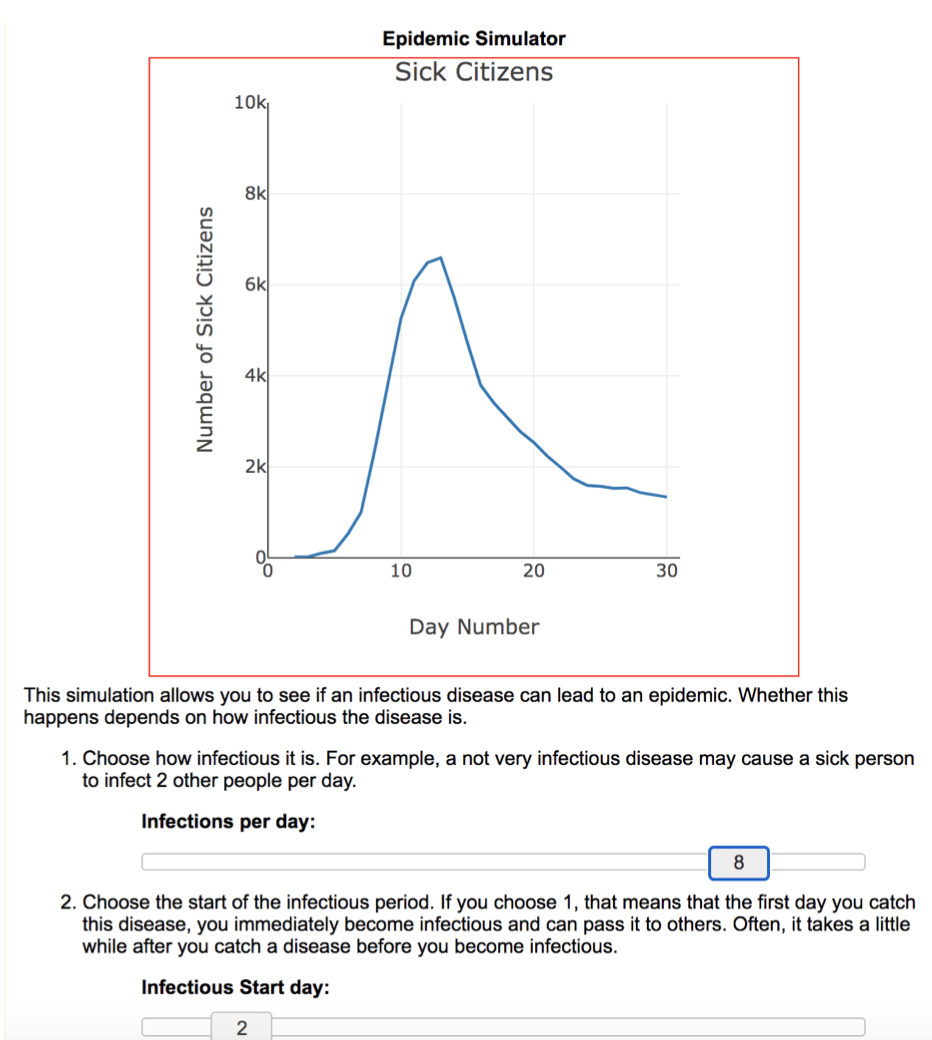
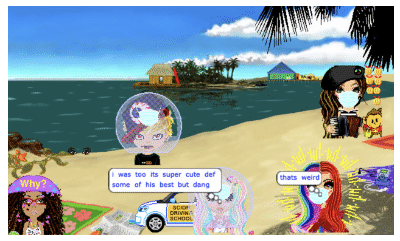
Enlarge…
Range of Preventive Equipment and Actions
PPE were offered at Jimmy’s table in the City Hall Lobby, at corresponding price points of in-world currency (i.e., more affordable measures were less effective) to simulate real economic barriers to healthcare access (see Table 1). Compared to free handwashing and cough-cover practices, bubbles were priced at 11,000 clams—an amount that would wipe out the middle 50% of Whyvillians’ savings. To provide discernability, we reported statistics on how players’ use of various preventive measures affected the infection rate (see Figure 6). Figure 8 shows Whyville citizens in a chat room, wearing single-use masks or bubbles.

| Mitigation | Image | Cost | Permanency of Protection | Transmission Effectiveness (Prevents Spread) | Reception Effectiveness(Prevents Infection) |
|---|---|---|---|---|---|
| Handwash |

|
free | Only Temporary | 10% | 15% |
| Cover |

|
free | Only Temporary | 10% | 0% |
| Mask |

|
50 for 50 clams | Disposable/single use, reapply upon entering each chat room | 20% | 0% |
| Sanitizer |

|
3 for 30 clams | Single use, reapply daily | 10% | 15% |
| Respirator |

|
200 clams | Reusable, permanent wear | 30% | 20% |
| Bubble |

|
11,000 clams | Reusable, permanent wear | 95% | 95% |
Method
Data Collection
Like past virtual viruses, SPIKEY-20 affected all of Whyville. Any citizen who logged on during the outbreaks was vulnerable to the disease. We collected two primary sources of data to address our research questions of who participated in the virtual epidemic, and how: (1) survey data on players’ self-reported experiences and attitudes related to SPIKEY-20 and COVID-19, and (2) logfile data on players’ epidemic-related behaviors and interactions on Whyville during the active outbreak. Using this evidence, we sought to understand players’ immersive and inquiry-based behaviors, to characterize their engagement with the virtual virus.
Logfile Data
First, we collected and analyzed anonymous logfile data from all players who logged onto Whyville during the outbreak from October 15 and November 15 in 2020 (N = 18,219). We narrowed this down to players who took any kind of action besides logging in (N = 13,996 players). In Whyville players receive a daily salary just for logging in, so it is a common practice to log in to build up cash without doing any other activities. From these players we focused on a subset of participants (N = 1,496 players) who performed at least one epidemic-related action (e.g., PPE usage, testing, information seeking; described further in the analyses and findings).
Gender was difficult to determine from the available data. Amongst the full sample (N = 13996), players identified as 5.9% male, 13.0% female, 0.2% non-binary, 80.9% unknown. Amongst the survey sample, players identified as 7.4% non-binary, 24.5% male, 68% female. Roughly twice as many female as male players seem to have participated, which is consistent with Whyville’s population over the decades, drawing mostly female players.
The logfile data provided by Numedeon covered player activity from October 1 - November 30, 2020, ranging from two weeks before to two weeks after the epidemic, allowing us to analyze whether and how player behavior changed during the epidemic. Data included general behaviors (e.g., logins, chat, game play, currency “clams” transactions), and two overarching types of epidemic-specific behaviors: prevention (e.g., purchasing PPE and using PPE or engaging in preventative behaviors), SPIKEY-20 infection status,), and information seeking behaviors (e.g., testing for infection, exploring CDC infection graphs, clicking on SPIKEY-20 announcements). In addition, because of the way Whyville collects and stores user interactions, we aggregated data into 4 to 5 day time spans, allowing us to see trends in player behavior over small chunks of time.
Survey Data
Second, through an advertisement on the homepage, N = 292 players completed a survey after the SPIKEY-20 outbreak. The survey assessed Whyvillians’ understanding of COVID-19 preventive measures and risks, and their feelings and self-reported actions around the virtual SPIKEY-20 virus, specifically about SPIKEY-20 design (e.g., “What did you think of SPIKEY-20: Like It, Not Like it, or Did Not Care?”). These also included open-ended questions where players could type written responses about what they liked/disliked about SPIKEY-20, and what they think caused SPIKEY-20 infection in avatars.
Analysis
With the logfiles, descriptive analyses were conducted to examine behaviors across time and identify any trends related to the spread of SPIKEY-20 in the Whyville community. To answer the question of who participated, we analyzed data regarding self-reported player age (aligning Whyville account with survey data and taking the lowest value when there were discrepancies), classroom membership (i.e., whether players were registered as part of a classroom), and players’ relative experience onsite, using “clam” savings and daily salary from October 1-4 (pre-epidemic). In Whyville, experienced players have usually saved up money (i.e., in virtual currency of “clams”) in bank accounts and are also likely to have a daily login salary based on accumulated levels gained in the various games. Thus, salary and bank accounts in Whyville are good measures of prior experience, differentiating new from experienced players. We also looked at whether players were registered independently on Whyville or as part of a class.
To study SPIKEY-20 epidemic-related behaviors, we identified six types of information seeking (i.e., unfurling SPIKEY homepage information banner, clicking on additional SPIKEY information, visiting Jimmy/Timmy City Hall tables, examining preventive measure options, checking infection graphs, and testing for infection), five types of PPE purchases (i.e., bubbles, single-use masks, hand sanitizer, respirators, and ineffective measures from past community infections), and two sets of preventive behaviors (i.e., using different paid PPE such as biohazard bubbles, masks, respirators, and hand sanitizer, and typing “wash” or “cover” into chat as free options). Note that purchases and usage of PPE are different. Purchasing PPE does not guarantee usage, so we differentiated these behaviors. Using the combined suite of epidemic-related behaviors (information seeking, PPE purchases, preventive behaviors), we examined the engagement in these behaviors across time and compared classroom and non-classroom epidemically-active participants.
To study whether players made an explicit connection to the COVID-19 pandemic, we conducted a comparative analysis of two open-ended survey questions where Whyvillians were asked to explain why they liked, disliked, or felt neutral about SPIKEY-20 and how they thought SPIKEY-20 infections spread. Two researchers developed an initial coding scheme, revised it, then tested it to achieve 100% agreement. Then all questions were independently coded and checked by both researchers.
Findings
As intended with our strategic and tactical virus designs, the SPIKEY-20 virus spread quickly through the Whyville community after initial seeding of the virus. Players’ preventive behaviors kept the infection curve tight: as quickly as the infections began, they also subsided, with the decline starting only 12 days after the start of infections (see Figure 6). Below we describe who participated in the epidemic, in what ways, and some evidence that players made active connections to their experiences with the active COVID-19 pandemic at the time.
Our data allowed us to consider players’ prior experience on Whyville, self-reported age, and registration as independent or classroom-based. Of the 13,996 players (including 303 registered as classroom players) who had a minimal level of activity beyond logging in during the time of the epidemic, 1,496 (including 198 classroom players) performed at least one epidemic-related action. All further analyses focus on these epidemically active 1,496 players.
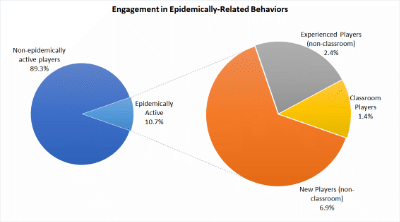
Enlarge…
Who Participated?
Among the 1,496 epidemically active players, we identified roughly three groups (see Figure 9). The first group appeared to be new players, or at least brand new Whyville accounts, as they had absolutely no salary and no clams in the bank (N = 963). The second group were experienced players who had a salary or cash in checking/savings accounts (N = 335). The third group of players were new classroom-based players (N = 198), who were all new to Whyville (no salary or clams). We attribute the high proportion of new players (both classroom and non-classroom users) to the success of social media and word-of-mouth campaigns outside of Whyville, drawing youth and classroom communities to experience the virtual epidemic. This is one way that the COVID-19 pandemic influenced participation in SPIKEY-20.

The 1,496 epidemically active players were distributed across a number of ages (see Figure 10), with adults (23-35 years old) as the largest number, followed by relatively similar distributions for young adults (19-23 years old), adolescents (13-18 years old) and children (under 12 years old). Looking more closely at classroom players, there was a fairly even split between children, teens, and college ages (i.e., primary, secondary, and college classes) (see Figure 11). This provides some insight into what kinds of teachers were drawn to the virtual epidemic and suggests a broad appeal across a range of school contexts. Personal communication by email suggested that at least two university preservice science education classes participated.


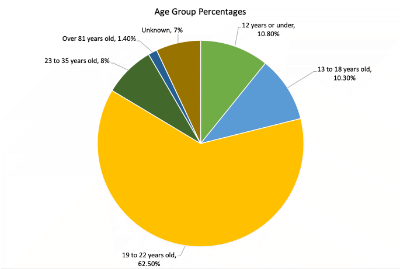
Enlarge…
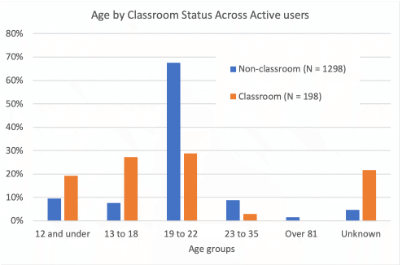
Enlarge…
Information & Testing

Enlarge…
By far the most common activity amongst users during the SPIKEY-20 epidemic was information seeking. From October 1 to November 30, there were 1,473 epidemically active players that engaged in at least 1 form of information seeking (based on the variables in graph below), with unique users checking information sources anywhere from 1 to 765 times. Unfurling the SPIKEY-20 information banner was by far the most popular way to engage in information seeking (see Figure 12, blue line and right axis scale), probably because it involved clicking a prominent alert on the homepage (first screen after login) that revealed a public service announcement about the SPIKEY-20 virus. A smaller proportion of epidemically active players (N = 389) sought more detailed information beyond the initial banner announcement. The second most common information seeking activity was to view preventive measures available for purchase in Whyville Jimmy/Timmy City Hall Tables (see Figure 12, left axis scale). Integrated and discernable actions, such as changing an avatar’s appearance with PPE cover or finding out one's own infection status, appeared more relevant to user experience, which could explain player’s heightened interest in viewing PPE and getting tested compared to other information seeking approaches.

The right axis focuses only on the most popular information source (unfurling SPIKEY-20 banner on the main login home page; axis and corresponding line in purple); the left axis shows the rate for all other information seeking behavior.
Information seeking spiked during the first several days of the epidemic, notably when infections started and when symptoms started showing (i.e., the four-day interval of October 15-19). Users were far more interested in things related to actions (i.e., preventive measures information, testing information) than pure observation (e.g., checking infection graphs). One interpretation is that users were invested in their personal avatar experience enough to take active steps to limit the chance of contracting or spreading SPIKEY-20. Relating to our guiding framework of providing a virtual event to make epidemics feel discernable and integrated, players’ decisions around which PPE to use and how often to use PPE directly impacted the continued spread to other Whyville players. This gave player decisions more weight as their avatar behaviors were integrated into the larger epidemic, and thus drew connections between discernible actions and more subtle in-world consequences (such as personal infection status and changes in the population-level infection rate).
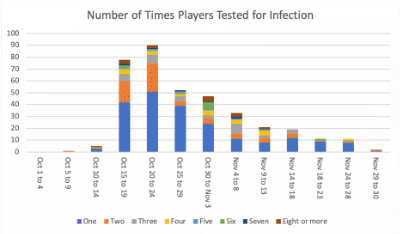
Enlarge…
With testing, there were 242 epidemically active players that got tested at least 1 time from October 1 to November 30, and 90 players who got tested at the peak of testing between October 20-24. Unlike the real-world constraints of testing availability, users took advantage of the virtual testing booth to conduct multiple tests in a short time, with unique users taking anywhere from 1-39 tests in each 4-day period (see Figure 13).

PPE Purchases & Preventive Behaviors
PPE purchases and preventive behaviors were a short step behind information seeking. PPE purchases peaked alongside information seeking during October 15-19, when infections began and symptoms first started (see Figure 14). Preventive behaviors (wearing/using PPE or handwashing/covering) peaked shortly after, from October 20-24, when symptoms from early-infected individuals were at their most severe (see Figure 15). Interestingly, preventive behaviors peaked just before the number of infected users peaked about 10-12 days after the start of infections (i.e., during the October 25-29 period, see community outbreak graph in Figure 7 for reference). Further, PPE use soared above the number of actual infections, which capped at just under 450 infected players at the peak of the outbreak. This suggests that as visible symptoms became more pronounced (i.e., discernable) and more people became infected, both infected and healthy individuals took steps to minimize the spread of SPIKEY-20.


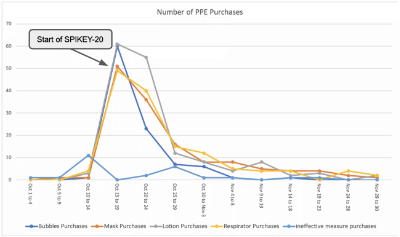
Enlarge…
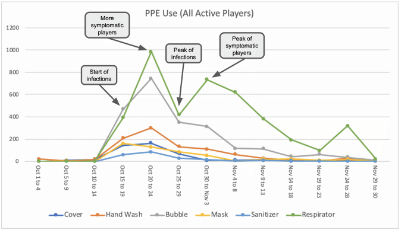
Enlarge…
Interestingly, preventive behaviors shifted during the epidemic. What was arguably the most cost-effective PPE—the reusable “respirator” masks, which prevented spread, had some protective qualities for the user, were multi-use, and were not prohibitively expensive—continued the longest. While extremely expensive bubble use dipped, respirator use continued throughout the epidemic, with a second (slightly lower) peak of usage just after the peak of infections from Oct. 30-Nov. 3. One interpretation is that this is an adaptive behavior. Users were likely weighing the benefits of optimal disease prevention against the economic costs of PPE purchases. Most players new to Whyville likely did not have the economic resources to purchase the highly expensive bubble. The “respirator” was also the only new PPE introduced in this epidemic. This adaptation was faster than Whyvillians’ behavior adaptation during the Dragon Swooping Cough, where they shifted to the newer and more effective PPE some weeks into that epidemic (Fields et al., 2017).
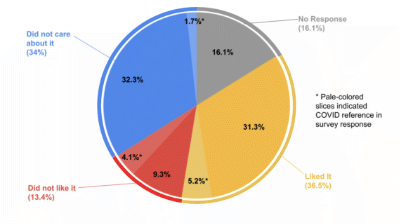
Enlarge…
Connection to COVID-19, a Real-Life Epidemic
One area that provided insight into connections some players made between the virtual epidemic and the real-life COVID-19 pandemic were the surveys about SPIKEY-20, in which 292 players responded to items about their experience of the SPIKEY-20 virus. As displayed in Figure 16, most players either ‘liked’ or ‘did not care’ about SPIKEY-20, while the remaining did not like it. Why the players liked or disliked SPIKEY-20 often related to connections to COVID-19.

The connections to COVID-19 were largely positive. Thirty players said that SPIKEY-20 helped them learn and/or connected to their real-life experiences (i.e., with COVID-19). Another 18 said they thought the virus was cool/fun/interesting, or that they enjoyed masking up and/or engaging in virus-related activities (e.g., wearing PPE, following population infection trends). Of the 39 players who didn’t like the virus, 11 found it annoying. For example, some referenced using PPE and still getting infected, or said they didn’t like how the PPE and/or SPIKEY symptoms looked on their avatar, or simply that they got infected and it interrupted their Whyville experience. Eight people didn’t like it because they said it was related to COVID-19 and they wanted a break from the real-life pandemic (i.e., “can’t escape COVID-19”). Five of the people who reported that they didn’t care about the virus were similarly annoyed at the connection to COVID-19, although some liked how the spikes looked, and others simply took the survey before they experienced enough of the virus to form an opinion.
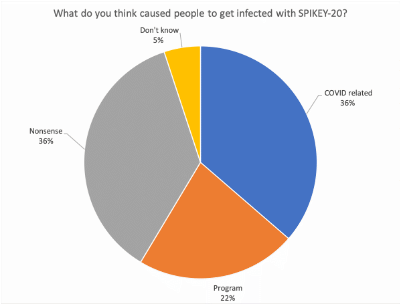
Enlarge…
Responses to the question “What do you think caused people to be infected with SPIKEY-20” revealed additional connections that players made between COVID-19 and SPIKEY-20. Even though technically the virtual epidemic was created with a programmatic algorithm, most respondents (104) thought that SPIKEY-20 was caused by things related to the real world COVID-19 virus: lack of social distancing, lack of wearing masks or not following rules (of which there were none regarding infectious disease in Whyville) or touching infected people. Only a relatively small portion of survey respondents (13) made any guesses related to computational or programmatic aspects. Of course, many respondents did not know (65), or wrote nonsensical comments or left the question blank (109). This suggests that in thinking about the virtual epidemic, the primary ideas of causal mechanisms were brought from real life and projected into virtual life. Further, most of the respondents who “liked” SPIKEY-20 also projected infection mechanisms that were related to COVID-19 transmission (58; 54% of respondents who liked SPIKEY-20). This further accentuates the idea that liking the virtual epidemic was related to it being connected to the real life pandemic in some way.

Clearly the open-ended responses to these two survey questions demonstrate that players made a connection between SPIKEY-20 and the real life experiences of COVID-19. Sixteen percent (N = 46) or just over one-fifth of survey-takers, mentioned COVID-19 and/or some direct connection to real life and learning, mostly in a positive manner, saying that it helped them understand something they were already curious about, or they felt it was important to help people learn more about the topic of viruses. Even more people (36%) projected a real-life COVID-19 infection mechanism in their thinking about how SPIKEY-20 spread on Whyville. The many direct and indirect references to COVID-19 suggest that the virtual epidemic design did succeed in creating connections between real and virtual epidemics.
One interesting finding is that the proportion of users who liked SPIKEY-20, or found it playful or interesting, was far higher than in the last major epidemic in Whyville. In the earlier Dragon Swooping Cough epidemic of 2015, negative affect far outweighed positive affect regarding the virus, and only a small minority of those with positive affect valued the virtual epidemic because of perceived learning benefits (e.g., Fields et al., 2017). Since one primary difference between the two virtual epidemics is that users were actively experiencing a global pandemic during SPIKEY-20, we take this to suggest that users found more meaning and relevance in connecting the virtual virus to their present-day lived experiences. Even among those who found the virus annoying, we saw evidence that the source of frustration for some was related to their real-life emotions about COVID-19.
Discussion
In this paper we introduced our strategic, tactical, and detailed design considerations of the SPIKEY-20 virtual epidemic that took place in Whyville in Fall 2020, concurrent with the worldwide COVID-19 pandemic. SPIKEY-20 succeeded in drawing a broad array of players (mostly aged 8-25) who engaged in a range of behaviors that included seeking information, purchasing PPE, and engaging in preventive behaviors. The frequency of epidemic participation varied greatly, reflecting typical trends of internet participation seen on other sites, where a small percentage of players engage in the most activities (e.g., Fields et al., 2016; Giang et al., 2012). However, in contrast to prior designs, the SPIKEY-20 virtual epidemic took place during a real life pandemic, and intriguingly, players responded in some different ways than previously. To our surprise, surveys showed that players predominantly liked SPIKEY-20, and many suggested that they liked it because it was relevant to real-life challenges linked directly with COVID-19.
In addition, player participation demonstrated how much the virtual context of Whyville has changed over the past 20 years. Unlike prior decades in Whyville which drew kids aged 8-16 in their free time, the virtual epidemic drew participation not just from kids aged 8-16 but also upper secondary age and young adults. Further, classroom players, while a minority of participants, were by far the most active players in the virtual epidemic, again likely because of perceived relevance to the concurrent real life pandemic and presumably with classroom supports for participation. Combined, these findings suggest that virtual epidemics may have new relevance to classroom education for all ages. Reflecting findings back to our initial strategic design principles of immersion, connection, and playfulness, below we explore how people responded to our epidemic design, in order to understand and design for richer engagement in future virtual events like the SPIKEY-20 outbreak.
Repeated Use of Testing
One of the most interesting ways that we saw players engage with the virtual virus was repeated successive testing to determine their avatar’s infection status. This behavior increased immersion by leveraging a discernible action: by getting tested, players quickly learned if their avatar was infected or not, and could make virus-related decisions accordingly. It was also a connected act. False positive and false negative testing probabilities directly paralleled real life testing uncertainties with COVID-19, adding to the sense of real and virtual continuity that players experienced with SPIKEY-20. Further, players had access to infinite, free, and instantaneous testing, avoiding the common real-life COVID-19 testing constraints of long lines, limited testing appointments, limited availability of tests, and wait-time to learn infection status. These intentional departures from real-world experiences added a playful element to the action of getting tested, resulting in players getting tested up to 39 times in a 4-day period. We consider this level of engagement a success from the perspective of actively engaging players in playful inquiry during the virtual epidemic.
Active and Adaptive PPE Use
Players quickly and eagerly adopted PPE. Compared to earlier virtual epidemics, players’ preventive behaviors began and adapted to the most cost effective use quickly (i.e., of reusable and mildly protective “respirators” masks). This swift adoption of preventive behaviors suggests first that experienced players likely remembered past virtual epidemics and transferred their prior behaviors quickly, and second, that new players may have been primed for preventive behaviors (like using masks) by the COVID-19 pandemic. In addition, it seems that players took into account the designed economics and relative effectiveness of PPE, purchasing the most affordable, higher quality protection. These behaviors also align with our design goals of making preventive behaviors discernible (i.e., visible to players with clearly communicated probabilities of effects) and integrated (i.e., making a difference in epidemic spread). How deeply players made connections with real life COVID-19 preventive behaviors would require a more extensive study of their in-world versus real-life preventive behaviors, and their reasoning about potential factors impacting COVID-19 spread rates before and after engaging with a virtual virus. Initial analyses of students’ Whyville Times reflections demonstrated that young people made thoughtful, even emotional connections between SPIKEY-20 and their personal experiences of COVID-19 (Tofel-Grehl, et al., 2021). A future study of players in a scaffolded educational setting, such as a classroom, could more qualitatively answer questions about connections in players’ virtual and real experiences of epidemics.
Considerations for Future Designs
One of the intentions for designing the SPIKEY-20 virus was to support players in developing skills to protect themselves and their communities in the event of a real-life epidemic, including seeking information about infection rates and transmission vectors. This was the logic behind creating a SPIKEY-20 banner, a public service announcement that players could unfurl at login, the widest-reaching interaction point for all players. The extremely high interaction with this information source highlights the stark contrast with other sources. For example, checking the population infection graph showed the lowest player engagement of all information sources almost throughout the entire epidemic.
We attribute this low engagement to the fact that these passive knowledge-building behaviors had low relevance for the daily life of Whyvillians. Unlike preventive behaviors, which can actively protect your own and others’ avatars, or even getting tested, which offers players a basis for other virus-related decision making, reading information sources on the virus (even live-updated ones) was less discernible and less integrated to the actual SPIKEY-20 epidemic. Logfile analysis indicated that players sought information to avoid SPIKEY-20. This is supported by trends in PPE purchases and use, where most people used whatever was the most effective and cost-balancing method, commonly choosing the popular “set it and forget it” option of reusable masks. Most player engagement across the entire epidemic was through discernible actions, which information seeking is decidedly not.
This finding is not unique to virtual epidemics, and in fact mirrors challenges faced by real-life epidemiologists. Population level changes (e.g., infections rates) are less discernible by nature than individual ones (e.g., personal infection status). Low information-seeking reflects the broader challenge in COVID-19 and other epidemics to support the wide-spread uptake of preventive behaviors in at-risk populations before infection symptoms become apparent in daily life. From a design perspective, this could be an opportunity where future educational virtual events could grow and make an impact. Designers should consider ways to make information-seeking behaviors less passive and more integrated as an active way to impact player experience. For example, perhaps in future Whyville epidemics, we could change information sources to incorporate simulators, so players could see how differential uptake of preventive behaviors across the Whyville population could change infection projections. The question of how to engage all players as adaptive and self-sufficient knowledge-builders will be critical to cultivating a citizenry equipped with microbial literacy to handle the changing demands of a future public health crisis like COVID-19.
Conclusions
As the world looks toward a post- or endemic-COVID era of education that recognizes the importance of public health and microbial literacy in future citizens (e.g., Timmis et al., 2019; Yoon, 2020), virtual worlds offer a unique avenue for learners to explore individual actions as embedded in and impactful on the overall health of broad social networks. Players in Whyville have explored virtual epidemics for years, but unique to this study was the global context of players experiencing a real-life pandemic while engaging with the virtual-life pandemic.
This study revealed a potential connection point between real-life and virtual public health behaviors, with player behaviors suggesting a cost-benefit calculus of engaging in the most active, cost-effective, convenient, and sustainable preventive behaviors in order to minimize infection. Another real and virtual epidemic similarity was a relatively lower engagement in passive behaviors, such as information-seeking and self-education behaviors to learn about the causes behind spread. Although this leads to the obvious challenge of individual health decisions based on potentially inaccurate and evolving recommendations from public service institutions (e.g., Whyville CDC) or worse, uninformed individual preferences, the design of virtual worlds can support engagement with scientifically-accurate public health information, while avoiding societal inequities revealed during the COVID-19 pandemic, such as politically biased mis- or disinformation, and social barriers to public health engagement.
Post-epidemic survey responses suggest that at least a portion of players did make explicit connections between COVID-19 and SPIKEY-20, understanding the virtual virus as a simulation of the real pandemic. More research is needed to determine if this conceptual connection spread beyond the small proportion of players who elected to discuss this relationship in their survey, and further, if the preventive practices they learned during the virtual simulation translated to more effective public health behaviors in real-life. Our ability to address that question was limited in the current study because of the nature of our virtual and self-report data. However, we are currently analyzing results from an investigation of an individual high school classroom that participated in the SPIKEY-20 epidemic, in order to determine changes in their understanding of epidemiological concepts relevant to pandemics (such as identifying vectors of spread or interpreting population-level infection statistics), as well as changes in their personal attitudes about and implementation of public health preventive behaviors (for early insights see Tofel-Grehl et al., 2021; Strawhacker et al., 2021).
Finally, the trends revealed in the SPIKEY-20 epidemic demonstrate a new potential audience rarely considered in prior research on virtual worlds: classroom students. This suggests that teachers found the virtual epidemic relevant to their classrooms’ learning. Not only this, but a range of classrooms, from elementary to college-age, participated in the SPIKEY-20 epidemic. In future iterations of virtual epidemics or other virtual world events, designers should consider the potentially wide range of ages events might appeal to as well as supports for classroom participation. Further, designers could consider developing immersive virtual worlds events that target other broad societal issues, from public health to environmental challenges facing society. Leveraging the massive and participatory nature of virtual worlds for immersive, playful, and connected learning in formal as well as informal education may provide a means to help learners tackle problems that require both individual and collective response within a community.
References
Ba, H. & Abrahamson, D. (2021). Taking Design to Task: A Dialogue on Task-Initiation in STEM Activities. Educational Designer, 4(14). ISSN 1759-1325. http://www.educationaldesigner.org/ed/volume4/issue14/article54
Barab, S., Pettyjohn, P., Gresalfi, M., Volk, C. & Solomou, M. (2012). Game-based curriculum and transformational play: Designing to meaningfully positioning person, content, and context. Computers & Education, 58(1), 518-533.
Bartle, R. A. (2003). Designing virtual worlds. New Riders.
Burkhardt, H. & Pead, D. (2020). 30 design strategies and tactics from 40 years of investigation. Educational Designer, 4(13). https://www.educationaldesigner.org/ed/volume4/issue13/article53/
Castranova, E. (2005). Synthetic worlds: The business and culture of online games. University of Chicago Press.
Dede, C., Nelson, B., Ketelhut, D. J., Clarke, J. & Bowman, C. (2004, June). Design-based research strategies for studying situated learning in a multi-user virtual environment. In Proceedings of the Sixth International Conference of the Learning Sciences (pp. 158-165).
Fields, D. A., Kafai, Y. B., Giang, M. T., Fefferman, N. & Wong, J. (2017, August). Plagues and people: engineering player participation and prevention in a virtual epidemic. In Proceedings of the 12th International Conference on the Foundations of Digital Games (pp. 1-10).
Fields, D. A., Kafai, Y. B. & Giang, M. T. (2016). Participation by choice: A transitional analysis of patterns in social networking and coding contributions in the online Scratch community. In U. Cress, H. Jeong & J. Moskaliuk (Eds.) Mass Collaboration and Education, New York, NY: Springer, pp. 209-240.
Giang, M. T., Kafai, Y. B., Fields, D. A. & Searle, K. A. (2012). Social interactions in virtual worlds: Patterns and participation of tween relationship play. In J. Fromme & A. Unger (Eds.), Computer games and new media cultures: A handbook on the state and perspectives of digital games studies. Springer Verlag. 543-556.
Goodwin, M. H. (1985). The serious side of jump rope: Conversational practices and social organization in the frame of play. Journal of American Folklore, 98(389), 315-330.
Jenkins, H., Purushotma, R., Weigel, M., Clinton, K. & Robison, A. J. (2009). Confronting the challenges of participatory culture: Media education for the 21st century. The MIT Press. Available at https://library.oapen.org/viewer/web/viewer.html?file=/bitstream/handle/20.500.12657/26083/1004003.pdf?sequence=1&isAllowed=y
Kafai, Y. B., Feldon, D., Fields, D., Giang, M. & Quintero, M. (2007). Life in the times of Whypox: A virtual epidemic as a community event. In C. Steinfeld, B. Pentland, M. Ackerman & N. Contractor (Eds.) Communities and Technologies (pp. 171-190). Springer.
Kafai, Y. B., Quintero, M. & Feldon, D. (2010a). Investigating the “why” in WhyPox: Casual and systematic explorations of a virtual epidemic. Games and Culture, 5(1), 116-135.
Kafai, Y. & Fefferman, N. (2010). Virtual epidemics as learning laboratories in virtual worlds. Journal of Virtual Worlds Research, 3(2).
Kafai, Y. B. & Fields, D. A. (2013). Connected play: Tweens in a virtual world. MIT Press.
Kafai, Y. B. & Giang, M. T. (2007). Virtual playgrounds: Children’s multi-user virtual environments for playing and learning with science. Children’s learning in a digital world, 196-217.
Lofgren, E. T. & Fefferman, N. H. (2007). The untapped potential of virtual game worlds to shed light on real world epidemics. The Lancet infectious diseases, 7(9), 625-629.
Neulight, N., Kafai, Y. B., Kao, L., Foley, B. & Galas, C. (2007). Children’s participation in a virtual epidemic in the science classroom: Making connections to natural infectious diseases. Journal of Science Education and Technology, 16(1), 47.
NGSS Lead States. (2013). Next Generation Science Standards: For states, by states. Washington, DC: The National Academies Press.
Oultram, S. (2013). Virtual plagues and real world epidemics: reflecting on the potential of online computer role-playing games to inform real world research. Med Humanities, 93, 115-118.
Puttick, G., Bernstein, D., Edwards, T. (2018) A Girl Scout Program Focused on Energy Conservation. Educational Designer, 3(10). http://www.educationaldesigner.org/ed/volume3/issue10/article37/
Reeves, T.C. (2011) Can educational research be both rigorous and relevant? Educational Designer, 1(4). https://www.educationaldesigner.org/ed/volume1/issue4/article13/
Resnick, M. & Silverman, B. (2005, June). Some reflections on designing construction kits for kids. In Proceedings of the 2005 Conference on Interaction Design and Children (pp. 117-122).
Salen, K. & Zimmerman, E. (2004). Rules of Play: Game Design Fundamentals. MIT Press.
Schott, G. & Hodgetts, D. (2006). Health and digital gaming: The benefits of a community of practice. Journal of Health Psychology, 11(2), 309-316.
Sigelman, C. K. & Glaser, S. E. (2019). Characterizing children’s intuitive theories of disease: The case of flu. Cognitive Development, 52, 100809. doi.org/10.1016/j.cogdev.2019.100809
Strawhacker, A., Kafai, Y., T. Giang, M., Fields, D. & Tofel-Grehl, C. (2021). Designing the Virtual SPIKEY-20 Epidemic: Engaging Youth in Seeking Information and Using Personal Protection. In Interaction Design and Children June 24–30, 2021, Athens, Greece. New York, NY: ACM, (pp. 558-562). doi.org/10.1145/3459990.3465208
Timmis, K. , Cavicchioli, R. , Garcia, J.L. , Nogales, B. , Chavarría, M. , Stein, L. , et al (2019) The urgent need for microbiology literacy in society. Environ Microbiol 21: 1513–1528.
Tofel-Grehl, C., Fields, D., Kafai, Y., Strawhacker, A., Hansen, T. & Giang M. (2021). Making connections to COVID: Students' sensemaking about prevention and behavior in a virtual epidemic. Paper presented at ESERA 2021: Fostering scientific citizenship in an uncertain world. Available at https://usu.box.com/s/2seal5u4yg58orx55l0kjhya8ux1zpzj
Vygotsky, L. S. (1978). Mind in society: The development of higher psychological processes. Harvard University Press.
Wilensky, U. & Abrahamson, D. (2006). Is a disease like a lottery? Classroom networked technology that enables student reasoning about complexity. Paper presented at the annual meeting of the American Educational Research Association, San Francisco, CA. Available at https://www.dropbox.com/s/er6998snke9lwjm/WilenskyAbrahamsonAERA2006.pdf?dl=0
Yoon, B. (2020). The global pandemic as learning opportunities about the world: Extending school curriculum. Middle Grades Review, 6(2), n2. https://scholarworks.uvm.edu/mgreview/vol6/iss2/







